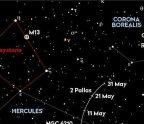How are planets destroyed at the end of a star's life?
In the process of becoming a white dwarf, a star like our Sun undergoes major changes involving its size and luminosity, when the star transforms into a so-called ‘giant star'. The star's size increases by a factor of hundreds, and it will easily swallow planets that are too close. For example, in the Solar System, Mercury and Venus






